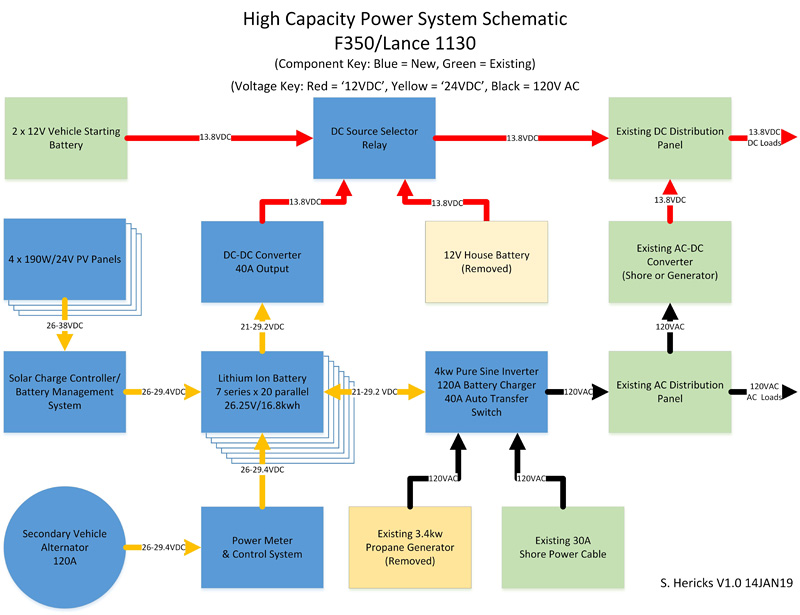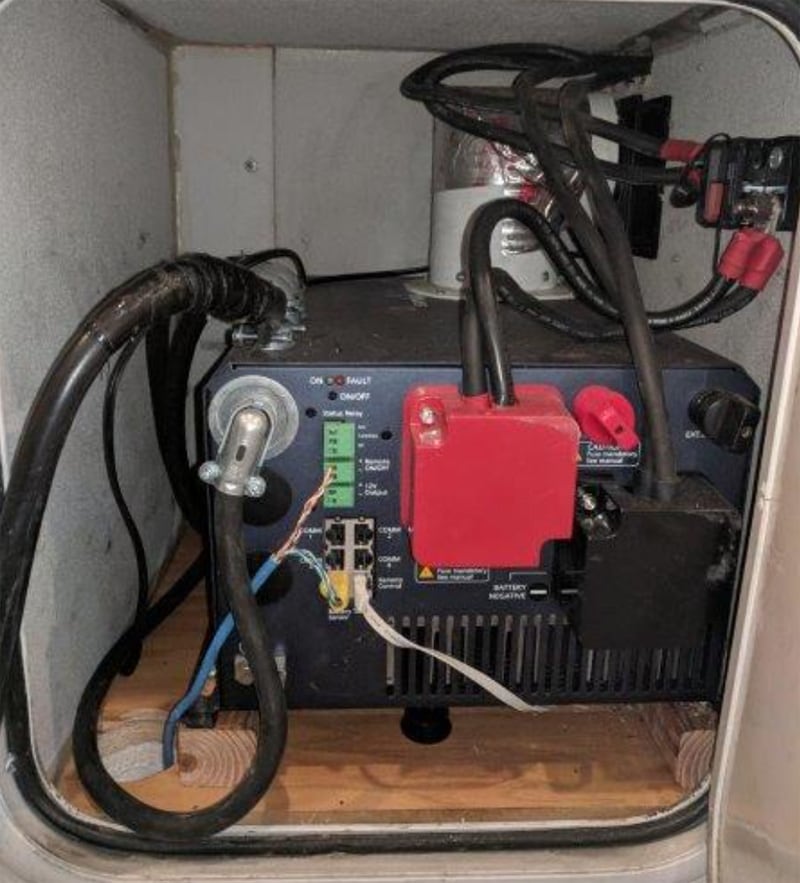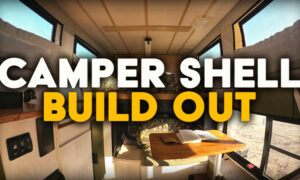Steve Hericks advances the state-of-the-art in RV power systems far beyond anything we’ve seen before. What he does next could power an entire camper; no propane or generators required. His test bed? A Lance truck camper.

In January we received an email from a Truck Camper Magazine reader that totally upended our thinking on RV power systems. Honestly, it took us the better part of a day to fully grasp what Steve Hericks had sent us. Then we looked up Steve’s work experience on LinkedIn and realized we had a major story on our hands.
Steve graduated from MIT in 1984 with a Bachelors of Science in Mechanical Engineering. After college, Steve served in the US Army obtaining two diplomas in Engineering from the US Army Engineer School and graduating with honors.
In the Korean demilitarized zone, Steve was a Heavy Equipment Platoon Leader, Combat Engineer Platoon Leader, Combat Engineer Platoon Leader, Company Executive Officer, Battalion Maintenance Officer and a Division Engineer Liaison Officer.
After Korea, Steve served a Battalion Maintenance Officer in Southwest Asia and Company Commander and Battalion Logistics Officer in Germany. Throughout his military service, Steve was responsible for the maintenance and logistical support of hundreds of vehicles and major equipment systems, and the combat engineers that serviced them.
In mid-1993, Steve retired from the service and went to work for Safari Motor Coaches as Manufacturing Engineer Manager. At Safari Motor Coaches, Steve developed advanced efficiencies and improvements to the equipment, manufacturing processes and quality control across the entire company and its product line. This included implementing Lean manufacturing and launching the use of CNC equipment.
After Safari, Steve worked for an industrial grade printing product company, a high-performance seal and connector manufacturer, and other mission critical equipment manufacturers. At each company he set out to revolutionize their manufacturing and process.
Today, Steve describes himself as semi-retired, but he’s not sitting. What follows is Steve’s complete reworking of a 2000 Lance 1130’s power and appliance systems. Nothing is left off the table. And the depth of his vision and plan is beyond anything we’ve seen before.
Did I mention Steve owns a M1088A1 Stewart and Stevenson 5-ton military tractor that he plans to make into a 20-foot fiberglass expedition vehicle? This Lance 1130 rebuild is just a warm-up to the main event.
Future Shock: A Bold Vision For RV Power Systems
by Steve Hericks
I bought a 2000 Lance 1130 as a base to begin experimenting with my own idea of what a truck camper should be. My final goal is to build a custom camper from scratch with all of my successful experiments integrated. This article was written to share what I have done to redesign the power system to support my plans.
The factory-installed Lance 1130 electrical system consists of a 3.4kW propane generator, 105Ah lead-acid battery and a 110-volt shore power cord. In addition, the Lance has a roof mounted air conditioner and a microwave that require either a generator or shore power. Even today, this is a fairly typical factory power and appliance system. And it’s nowhere near adequate for what I want to do.
The Goal: Full-Time Off-Grid In Comfort
We all want something different from our RV. That’s one of the reasons why there are so many different styles and floor plans.
I travel to enjoy the sights and wide-open spaces and do not want to live elbow-to-elbow with my countrymen in an RV park. With a truck camper and four-wheel drive diesel truck, I can go where almost everyone else can’t go.
I grew up backpacking in Montana and lived in tents all over the world serving in the Army. I can rough-it with the best of them, but long ago overcame needing to prove it.
Now I enjoy my comforts and intend to ensure that I have an RV that supports a comfortable lifestyle on the road. I’ve been a practical engineer long before I earned my degree and spent my second career in manufacturing and engineering. I recently retired with the goal of working my way into full-time RVing.
The Objectives
If I am going to live in a small footprint long-term, I want equipment that performs well, efficiently, and reliably. To begin to plan the system, I set some clear objectives:
1. Dry camp almost exclusively. No hookups.
2. Heat the camper and water with diesel fuel sourced from the truck’s tank.
3. Operate any 12-volt or 110-volt on-board equipment at will. No shore power required.
4. Ability to operate multiple on-board appliances simultaneously.
5. Change to energy efficient appliances. Eliminate propane furnace and three-way refrigerator.
7. Eliminate the weight, maintenance, noise and space of the on-board generator.
8. Eliminate the weight, space and refill hassle of the propane system.
To achieve these objectives, I needed to make a considerable redesign of the way some of the RV systems were originally conceived by the manufacturers. After considerable thought, I came to the following conclusions:
A. Lithium Batteries are the only answer, and lots of them. More on this in Part 2.
B. Generate electricity actively and passively.
C. Make efficient use of energy generated.
D. Provide redundancy for key systems.
What Should the Electrical System Be Capable Of?
To frame the project, this is the first question that needs to be defined. First I need to identify the loads, both AC and DC. Requirements lead to specifications which lead to equipment selection.
My most aggressive objective is to use the air conditioner for a 24-hour period while being able to use two other appliances simultaneously. This is a very demanding goal. If I am in a boondocking situation where I don’t need air conditioning, I would like to operate for five days from the battery with some solar replenishment.
To determine the peak and continuous duty requirements, I need to estimate the AC continuous duty loads (NEC standard is over four hours/day) and intermittent loads (less than four hours a day). Let’s break down the appliance energy requirements.
The Appliance’s Energy Requirements
Before designing a power system, it’s important to survey and calculate your power requirements. This means evaluating the power requirements of your camper components, and your general use practices. What follows are my findings when calculating my power requirements.
The Dometic 11,000 BTU air conditioner (from model year 2000 – not very efficient) draws 16-amps running and takes 21-amps to start. After careful evaluation, the air conditioner uses a 30-percent duty cycle during peak heat and a 20-percent duty cycle during non-peak heat. A 30-percent duty cycle means the compressor is running 3-minutes out of 10.
Since I have the ability to move my home to somewhere cooler, my need for air conditioning should not be excessive or lengthy. However, air conditioning may be needed to keep my dog comfortable when I go hiking on a warm day.
The Samsung microwave runs at about 7.5-amps. This and an induction cooktop are the primary cooking appliances. I anticipate using the microwave about 30-minutes a day.
The induction cooktop runs 3 to 12-amps; probably 6-amps average. I anticipate using about 30-minutes of induction cooking per day.
The blender runs at 4-amps. It only gets used for breakfast a few minutes a day. The coffeemaker runs at 6-amps for a few minutes in the morning only.
The furnace draws 10-amps to run the blower. Assume a 20-percent duty cycle and that it never runs with the air conditioner (obviously).
As a side note, my custom camper will use a diesel air heater which draws 6-amps, but I will use the current propane furnace for my energy calculations.
Add two more amps for operation of minor AC loads for a total of an hour. DC loads are typically lower power than the AC loads but, like the air conditioner, some of them consume substantial energy because they run for a long time.
Additional Small Electrical Draws On The System:
Detectors (smoke, propane and CO), 1-amp total
Lights (LED/florescent), 1-amp per fixture
Television – 4-amps
Range vent hood and light, 3-amps
Ceiling vent, 2-amps
Two-way refrigerator (gas mode), 2-amps
A High-Capacity Power System
The below diagram summarizes the native system and what I added and subtracted. As I discuss the how and why of the new systems, keep in mind that it is my intent to remove these systems and transfer them to a custom camper. The 1130 will be restored to factory stock.

Determining the Required Inverter Size
Using the above loads, we can figure out the highest demand. Let’s assume the air conditioner is running along with two appliances and a few wall warts. The peak load is the continuous plus intermittent loads.
Assume the appliances are all running when the air conditioner wants to start; 21-amps + 7.5-amps + 6-amps + 2-amps = 35.5-amps. The peak load capacity of the inverter needs to be around; 35-amps x 120-volts = 4,260-watts!
The continuous duty load is just the air conditioner; 16-amps x 120-votes = 1,920-watts.
Since our major loads are inductive (motors or transformers), the inverter needs to a pure sine wave model so it will behave with large inductive loads.
Low frequency inverter designs have a big transformer inside them making them two to three times the weight of a high frequency inverter. They also tend to handle inductive loads better and for far longer (minutes or more, not seconds).
With these requirements, and assuming a 20-percent safety margin, the inverter should be a minimum of 2.5kW with a peak capacity of about 5kW.

I chose a Samlex EVO 4024 combined inverter, charger and automatic transfer switch that is lithium compatible.
Most inverters – especially cheap Chinese inverters – are not designed to operate on the range of voltages that lithium batteries cover. If they have integrated chargers, the charger is likely unable to provide the correct charging profile for lithium.
The Samlex EVO 4024 operates on 24-volts DC, provides 4kW continuously, has a 110-amp charger and a 75-amp automatic transfer switch. I mounted it inside the passenger’s side rear cargo box. It barely fits and required special ventilation to keep it happy.
Determining the Required Battery Bank’s Size
Now that we know about how big the inverter is going to be and what the running draw of the loads are, we need to estimate the power they consume in a 24-hour day.
AC Loads:
Air conditioning; 16-amps x 120-volts x (8-hours x 30-percent + 16-hours x 20-percent) = 10.8kWh
Cooktop; .5-hour x 8-amps x 120-volts = .48kWh
Microwave; .5-hour x 7.5-amps x 120-volts = .45kwh
Coffeemaker; .25-hour x 6-amps x 120-volts = .18kwh
Blender; .05-hour x 4-amps x 120-volts = .024kwh
Misc AC loads; 1-hour x 2-amps x 120-volts = .24kwh
DC Loads:
Furnace; 24-hours x 10-amps x 12-volts x 20-percent = .576kwh
Detectors (smoke, propane and CO); 24-hours x 1-amps x 12-volts = .288kwh
Lights (LED/florescent), 1-amps/fixture; 4-hours x 2-fixtures x 1amps x 12-volts = .096kwh
Television; 2-hours x 4-amps x 12-volts = .096kwh
Range vent hood and light; .3-hour x 3-amps x 12-volts = .108kwh
Ceiling vent; 4-hours x 2-amps x 12-volts = .096kwh
Refrigerator, three-way absorption (in gas mode); 24-hours x 2-amps x 12-volts = .576kwh
Refrigerator, DC compressor; 24-hours x 5-amps x 12-volts = 1.44kwh (for reference)
Note: Two refrigerator comparisons are listed because I will be transitioning from the standard three-way refrigerator to a DC compressor refrigerator. Absorption refrigerators consume about 400-watts of power. About 350-watts of heat comes from either propane or electricity and 48-watts of DC is needed to operate the controls. In contrast, a DC compressor refrigerator takes about 60-watts total. No kidding!
AC loads (including air conditioning: 12.174 kwh + DC loads (less furnace); .904kWh = 13.077kwh/day.
Obviously, the air conditioner load is huge relative to everything else. There are good reasons why you can’t typically run your air conditioner on battery power, but let’s see what it would take to do it if we wanted.
Assume we were to use a lead acid, Group-31, 12-volt battery for the above demand. This Group-31 battery is rated at 105Ah x 12-volts = 1.260kWh. But, to preserve operating life of the battery, we only run it down to 50-percent depth of discharge (DOD).
This means the battery’s effective capacity is .63 kWh. So how many Group-31 batteries would I need? 13.077kwh/.63kwh/battery = 21 batteries. Clearly that’s a non-starter for lead acid. By the way, each battery weighs about 75 pounds. Multiplied by 21 batteries and that battery bank would weigh 1,575 pounds!
System Weight: 600-Pounds Net
Speaking of weight, weight is always a big issue for truck campers. At this point, additions are around 800-pounds and deletions are around 200-pounds; a net increase of 600-pounds.
Current weight changes are Lithium-ion battery (+300-pounds), battery compartment (+100-pounds), inverter/charger (+78-pounds), house battery (-100 pounds), PV panels (+168 pounds), panel mounts/wiring (+38 pounds), and generator (-98 pounds).
Planned weight changes to be made if/when diesel space and water heating are implemented are two 30-pound propane tanks (-50 pounds + weight of gas), gas range (-30 pounds), gas water heater (-50 pounds), furnace (-28 pounds), diesel air heater (+6 pounds), diesel coolant heater (+11 pounds).
Some of the additions will be eliminated in the transition to the new camper. With the implementation of the diesel heaters, I anticipate further weight reduction. The big equalizer will be removing the truck cargo box and mounting the camper directly to the truck.
Next: Nissan Leaf EV Battery System Installation
How in the world is Steve going to power his vision? By employing the lithium batteries from a Nissan Leaf EV, of course!
Click here to see one of the most incredible truck camper modifications ever attempted; installing a Nissan Leaf EV Battery System – in a Lance 1130!
























